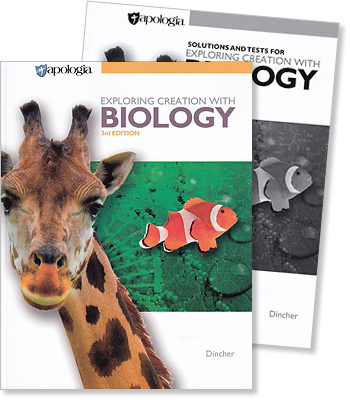
Grade 9 Apologia Biology [3rd Ed] Set
- Paper cover
- 6.522 lbs
Item #52-09--
| This set includes: | # in My Cart | ||
|---|---|---|---|
| Pupil Textbook | $87.00 | ||
| Solutions and Tests Manual | $26.00 | ||
| This set includes: 2 items (set discount: 5%) | -$5.65 | ||
This high school biology course is designed to be the homeschool student's first high school science class and is college-prep. Exploring Creation with Biology, 3rd Edition, is a foundational course that covers everything students need to prepare successfully for a college-level biology course. The updated edition includes more in-depth explanations of certain concepts and new graphics to help students understand the life sciences.
In this course, your student will:
- See the evidence of God’s creation as they learn scientific principles
- Conduct experiments in a methodical way that prepares them not just for future classes, but for life
- Take personal notes, conduct and record experiments, and be able to interpret results
- Develop skills to think through and beyond the textbook materials, and be able to create their own experiments from concept to interpretation of results
- Further develop skills in their own learning style and how they best process, record, study, and retain information learned
- Be able to hold a logical discussion on God and science based on facts and beliefs
This revised edition offers:
- Updated content to present the most current science
- A reorganized structure of the information, which helps students logically progress through their biological studies
- Experiments which have been updated or replaced, and the addition of new experiments
- New illustrations and infographics that help students break down and visually digest difficult concepts, in addition to updated images and illustrations
- New content, including a new section on photosynthesis and a new section on diseases
- An overhaul of the section on genetics, including more information on DNA
Contents
MODULE I: THE SCIENCE OF LIFE
- The Process of Science
- What Scientists Do
- Observations and Inferences
- Hypotheses
- Experiments
- Scientific theories and Laws
- Scientific Method in Action
- The Limitations of Science
- Spontaneous Generation
- Redi's Experiments Refute Spontaneous Generation
- Discovering Microorganisms
- Pasteur's Experiment
- Why Study Science?
- Spontaneous Generation: Some Still Cling to It!
- The Study of Life
- Cells and Life
- Growth and Development
- Metabolism and Energy
- Homeostasis
- Sensing and Responding to Stimuli
- DNA and Reproduction
- Tools of Biology
- A Common Measurement System
- Tables and Graphs
- Microscopes
- Light Microscopes
- Electron Microscopes
- Experiment 1.1: Introduction to the Microscope
- Safety in Biology
- Answers to the On Your Own Problems
- Study Guide for Module 1
MODULE 2: THE CHEMISTRY OF LIFE
- The Composition of Matter
- Atoms: the Basic Building Blocks of Matter
- Atomic Structure
- Elements
- Isotopes
- Radioactive Isotopes
- Molecules and Compounds
- Chemical Formulas
- Chemical Bonds
- Ionic Bonds
- Covalent Bonds
- The Properties of Water
- Experiment 2.1: Investigating Water's Properties
- The Structure of Water
- Life-Supporting Properties of Water
- The Universal Solvent
- Cohesion, Surface Tension, and Adhesion
- High Heat Capacity
- Density of Ice
- Carbon Compounds
- Carbohydrates
- Functional Groups and Organic Acids and Bases
- Experiment 2.2: How Effective is Your Antacid?
- Lipids
- Proteins and Enzymes
- Protein Structure
- Enzymes
- Experiment 2.3: the Fragility of an Enzyme
- Nucleic Acids
- Answers to the On Your Own Problems
- Study Guide for Module 2
MODULE 3: ECOLOGY
- Introduction
- Energy and Life
- Producers, Consumers, and Decomposers
- Food Chains, Food Webs, and Trophic Levels
- Energy Moves Through Trophic Levels
- Ecological Pyramids
- Energy Pyramids
- Biomass Pyramids
- Pyramids of Numbers
- The Biosphere
- The Water Cycle
- The Carbon Cycle
- Experiment 3.1: Carbon Dioxide and the Greenhouse Effect
- Global Climate
- The Oxygen Cycle
- The Nitrogen Cycle
- The Phosphorus Cycle
- Ecosystems and Biomes
- Factors that Affect Ecosystems
- Biotic and Abiotic Factors
- Climate
- Major Biomes
- Terrestrial Biomes
- Aquatic Biomes
- Marine Biomes - the Ocean Biome
- Marine Biomes - Coral Reefs
- Marine Biomes - Estuaries
- Standing Freshwater Biomes—Lakes and Ponds
- Running Freshwater Biomes—Rivers and Streams
- Freshwater Biomes—Wetlands
- Populations and Communities
- Community Interactions—Competition
- Intraspecific Competition
- Interspecific Competition
- Community Interactions—Predation
- Community Interactions—Symbiosis
- Community Disturbances
- Primary Succession
- Secondary Succession
- Characteristics of Populations
- Population Growth
- Exponential Growth
- Logistic Growth
- Limits to Growth
- Experiment 3.2: How Does Competition Affect Plant Growth?
- Answers to the On Your Own Problems
- Study Guide for Module 3
MODULE 4: CELL STRUCTURE AND FUNCTION
- Introduction
- History of Cell theory
- The Cell theory
- Characteristics of Cells
- Cell Structure
- Structures That All Cells Have in Common
- The Plasma Membrane
- The Cytoplasm
- Ribosomes
- Organelles of Eukaryotic Cells
- Cell Wall
- The Nucleus
- The Endoplasmic Reticulum
- The Golgi Apparatus
- Vacuoles and Vesicles
- The Lysosome
- The Peroxisome
- The Mitochondrion
- The Plastids
- The Cytoskeleton
- Centrioles
- Experiment 4.1: Plant and Animal Cell Structure
- A Closer Look at Membranes
- Movement Through Membranes
- Passive Transport: Diffusion
- Passive Transport: Osmosis
- Experiment 4.2: Osmosis in Animal Cells
- Osmosis in Living Cells
- Experiment 4.3: Plasmolysis in Plant Cells
- Passive Transport: Facilitated Diffusion
- Active Transport
- Answers to the On Your Own Problems
- Study Guide for Module 4
MODULE 5: CELLULAR ENERGY
- Introduction
- ATP: the Energy Currency of Cells
- Photosynthesis: Making Energy-Packed Food
- Experiment 5.1: Pigments of Photosynthesis
- Paper Chromatography
- the Light Reactions
- the Calvin Cycle
- Cellular Respiration: Making ATP
- Mitochondrial Design
- The Stages of Cellular Respiration
- Stage 1: Glycolysis
- Stage 2: the Link Reaction
- Stage 3: the Krebs Cycle
- Stage 4: the Electron Transport Chain
- Fermentation
- Experiment 5.2: Cellular Respiration and Fermentation in Yeast
- Answers to the On Your Own Problems
- Study Guide for Module 5
MODULE 6: DNA, PROTEINS, AND THE CELL CYCLE
- Introduction
- DNA, Genes, and Chromosomes
- A Brief History of the Discovery of DNA
- Genes and Chromosomes
- Experiment 6.1: DNA Extraction
- DNA Replication
- Protein Synthesis
- Protein Synthesis Part 1: Transcription—DNA to RNA
- Editing RNA
- Protein Synthesis Part 2: Translation—RNA to Protein
- Adding Amino Acids
- Summarizing Protein Synthesis
- Cell Cycle and Cellular Reproduction
- Mitosis
- Prophase
- Metaphase
- Anaphase
- Telophase and Cytokinesis
- Experiment 6.2: Mitosis
- Meiosis
- Counting Chromosomes
- The Process of Meiosis
- Meiosis I: Prophase I
- Meiosis I: Metaphase I
- Anaphase I
- Telophase I and Cytokinesis
- Prophase II
- Metaphase II
- Anaphase II
- Telophase II and Cytokinesis
- Answers to the On Your Own Problems
- Study Guide for Module 6
MODULE 7: GENETICS
- Introduction
- Experiment 7.1: Environmental Factors and their Effect on Radish Leaf Color
- Mendalian Genetics
- Mendel's Experiments
- Modern Terminology
- Inheritance and Meiosis
- Punnett Squares
- Testcross
- Pedigrees
- Experiment 7.2: Making Your Own Pedigree
- More Complex Crosses
- Meiosis and Dihybrid Crosses
- Inheritance Patterns
- Sex-Linked Genetic Traits
- Non-Mendalian Inheritance Patterns
- Human Genetics
- Autosomal Disorders
- Sex-Linked Disorders
- Disorders Caused by Damaged Genes
- Disorders Caused by Damaged Chromosomes
- Disorders Due to Change in Chromosome Number
- Gene Technologies
- Restriction Enzymes
- Gel Electrophoresis and DNA Profiling
- Polymerase Chain Reaction
- Genetic Engineering and Recombinant DNA
- Summing Up
- Answers to the On Your Own Problems
- Study Guide for Module 7
MODULE 8: EVOLUTION
- Introduction
- Charles Darwin
- Darwin's theory
- Microevolution and Macroevolution
- A Closer Look at Macroevolution
- Macroevolution Today
- The Geological Column and the Fossil Record
- A Detailed Look at the Fossil Record Evidence
- The Cambrian Explosion
- Punctuated Equilibrium and Gradualism
- Structural Homology
- Molecular Biology
- Why Do So Many Scientists Believe in Macroevolution?
- Answers to the On Your Own Problems
- Study Guide for Module 8
MODULE 9: PROKARYOTES AND VIRUSES
- Introduction
- Biological Classification
- Five Kingdoms or Six Kingdoms?
- Overview of Three Domains and Four Kingdoms
- Classifying Phylum, Cclass, Order, Family, Genus, and Species using Biological Keys
- Experiment 9.1: Using a Biological Key
- Archae and Bacteria
- Archae
- Bacteria
- Bacterial Cell Structure (a review)
- Identifying Bacteria
- Shape
- Cell Wall Structure
- Movement
- Getting and Releasing Energy
- Autotraphs
- Heterotrophs
- Cellular Respiration
- Conditions for Bacterial Growth
- Reproduction
- Genetic Variation in Bacteria
- Conjugation
- Transformation
- Transduction
- Bacteria in Nature
- Chemical Recyclers and Bioremediation
- Bacteria and Humans
- Bacteria and Disease
- Experiment 9.2: Bacterial Fermentation—Making Yogurt
- Viruses
- Viral Structure
- How Viruses Infect
- The Lytic Cycle
- The Lysogenic Cycle
- Defenses Against Viruses
- Answers to the On Your Own Problems
- Answers to Experiment 9.1
- Study Guide for Module 9
MODULE 10: PROTISTS AND FUNGI
- Introduction to Protists
- Experiment 10.1: Pond Life—Part A
- General Characteristics of Protists
- Classifying Protists
- Animal-Like Protists—The Protozoans
- Protozoans with Pseudopodia—Sarcodines
- Protozoans with Flagella—Zooflagellates
- Protozoans with Cilia—Ciliates
- Other Ciliates
- Nonmotile Protozoans—Sporozoans
- Fungus-Like Protists
- Slime Molds
- Cellular Slime Molds
- Acellular Slime Molds
- Water Molds and Mildews
- Plant-Like Protists—Euglena and Algae
- Euglena
- Flame-Colored Algae—Dinoflagellates
- Golden Algae—Diatoms
- Gree Algae
- Other Members of Chrysophyta
- Red Algae
- Brown Algae
- Experiment 10.2: Protozoans, Algae, and Pond Life—Part B
- Introduction to Fungi
- General Characteristics of Fungi
- Structure and Function
- Reproduction in Fungi
- How Fungi Spread
- Classifying Fungi
- The Common Molds—Zygote Fungi
- Structure and Function of Zygote Fungi
- Life Cycle of Zygote Fungi
- Experiment 10.3: Molds
- Sac Fungi
- Yeast
- Experiment 10.4: Yeast
- Other Sac Fungi
- Club Fungi
- The Life Cycle of Club Fungi
- Diversity of Club Fungi
- Experiment 10.5: Club Fungi
- Chytrids
- Imperfect Fungi
- How Fungi Impact Life
- Decomposers
- Symbiotic Relationships
- Pathogens
- Summing Up
- Onswes to the On Your Own Problems
- Study Guide for Module 10
[Remainder shows only main module topics...]
MODULE 11: PLANT DIVERSITY AND REPRODUCTION
- Introduction to Plants
- Classifying Plants
- A Closer Look at the Angiosperm Life Cycle
- Answers to the On Your Own Problems
- Study Guide for Module 11
MODULE 12: PLANT STRUCTURE AND FUNCTION
- Introduction to Plant Anatomy and Physiology
- Plant Structure
- Transporting Water and Nutrients
- Plant Growth, Hormones, and Responses
- Unique Designs
- Answesr to the On Your Own Problems
- Study guide for Module 12
MODULE 13: ANIMALS—INVERTEBRATES PART 1
- Introduction
- Characteristics of Animals
- Diversity of Invertebrates
- Summing Up of Invertebrates
- Answers to the On Your Own Problems
- Study Guide for Module 13
MODULE 14: ANIMALS—INVERTEBRATES PART 2
- Introduction
- A Closer Look at Arthropods
- The Diversity of Arthropods
- A Bit About Echinoderms
- Summing Up
- Answers to the On Your Own Problems
- Study Guide for Module 14
MODULE 15: ANIMALS—CHORDATES PART 1
- General Characteristics of Chordates
- Nonvertebrates Chordates
- General Characteristics of Vertebrates
- Diversity of Vertebrates—Fishes
- Diversity of Vertebrates—Amphibians
- Diversity of Vertebrates—Reptiles
- Answers to the On Your Own Problems
- Study Guide for Module 15
MODULE 16: ANIMALS—CHORDATES PART 2
- Introduction
- Birds
- Classification in Class Aves
- Mammals
- Animal Behavior
- Summing it All Up
- Answers to the On Your Own Problems
- Study Guide for Module 16
- End Letter
- Appendix A
- Appendix B: A Complete List of Lab Supplies
- Glossary
- Index
Customers who bought this product also bought
Customers who viewed this product bought








